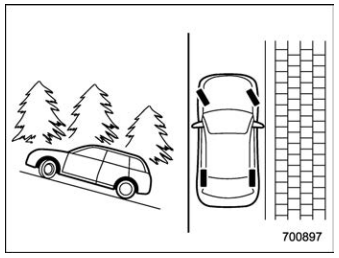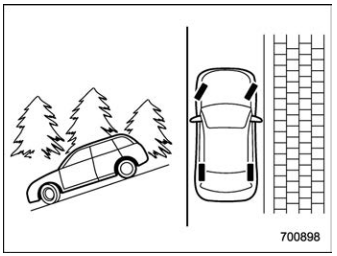Subaru Forester 2019-2025 Owners Manual / Starting and operating / Parking your vehicle / Parking tips
Subaru Forester: Parking your vehicle / Parking tips
When parking your vehicle, always perform the following items.
- Apply the parking brake firmly.
- Put the select lever in the “P” position.
Never rely on the mechanical friction of the transmission alone to hold the vehicle.

When parking on a hill, always turn the steering wheel. When the vehicle is headed up the hill, the front wheels should be turned away from the curb.

When facing downhill, the front wheels should be turned into the curb.
WARNING
- Never leave unattended children or pets in the vehicle. They could accidentally injure themselves or others through inadvertent operation of the vehicle. Also, on hot or sunny days, the temperature in a closed vehicle could quickly become high enough to cause severe or possibly fatal injuries to people.
- Do not park the vehicle over flammable materials such as dry grass, waste paper or rags, as they may burn easily if they come near hot engine or exhaust system parts.
- Be sure to stop the engine if you take a nap in the vehicle. If engine exhaust gas enters the passenger compartment, occupants in the vehicle could die from carbon monoxide (CO) contained in the exhaust gas.
CAUTION
- If your vehicle has a bumper under guard (optional), pay attention to blocks and other obstructions on the ground when parking. The underspoiler could be damaged by contact with them.
- The braking power of the parking brake may not be sufficient when stronger braking power is needed (e.g., when parking on a steep slope while towing a trailer).
 Auto Start Stop system
Auto Start Stop system
The Auto Start Stop system is designed to
automatically stop and restart the engine
when the vehicle is stationary for a short
period of time (while waiting for a traffic
light or in a traffic jam) after the engine has
warmed up...
Other information:
Subaru Forester 2019-2025 Owners Manual: Reclining the seatback (if equipped)
WARNING To prevent the passenger from sliding under the seatbelt in the event of a collision, observe the following precautions: Keep the seatback in the upright position while the vehicle is in motion. Do not place objects such as cushions between the passenger and the seatback...
Subaru Forester 2019-2025 Owners Manual: Rocking the vehicle
If you must rock the vehicle to free it from snow, sand, or mud, depress the accelerator pedal slightly and move the select lever back and forth between “D” and “R” repeatedly. Do not race the engine. For the best possible traction, avoid spinning the wheels when trying to free the vehicle...
Categories
- Manuals Home
- Subaru Forester Owners Manual
- Subaru Forester Service Manual
- Disabling functions
- Shift lock release using the shift lock release button
- Vehicle load limit – how to determine
- New on site
- Most important about car
Driving information display
NOTE
You can set the units for both the multifunction display (black and white) and the combination meter at the same time. For details about setting the language and units, refer to “Type A combination meter” or “Menu screens”.
Copyright © 2025 www.suforester5.com

